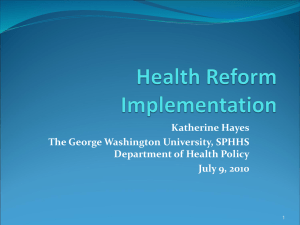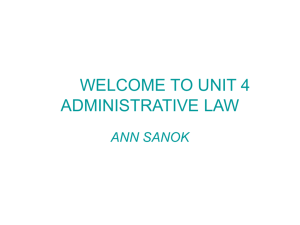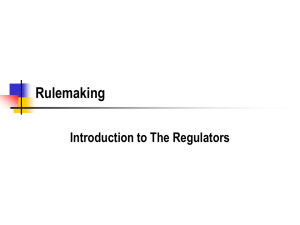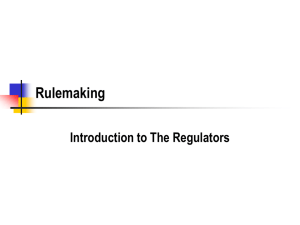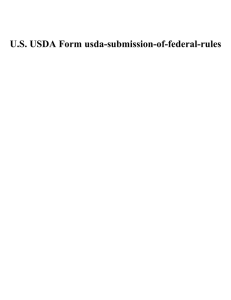Rulemaking Part III
advertisement
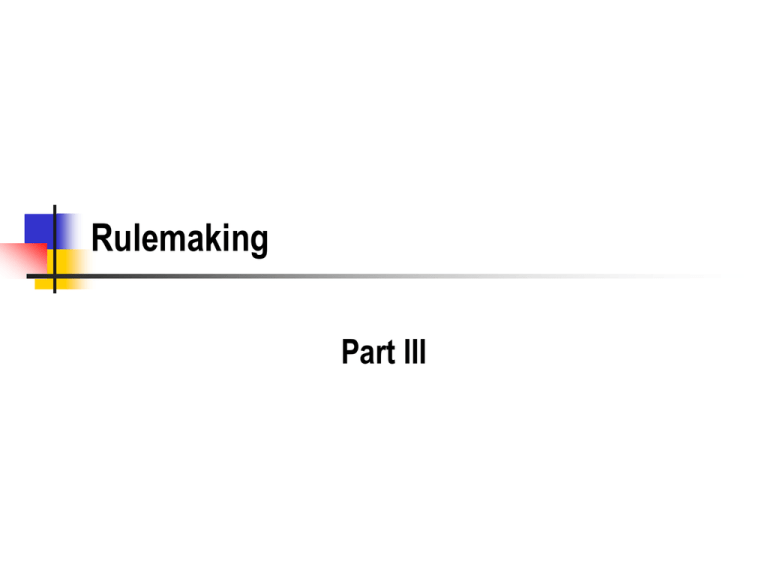
Rulemaking Part III Procedural Rules Procedural rules are exempt from notice and comment The form of an application for benefits is procedural The facts that the claimant has to establish to get the benefits are substantive A procedural rule can become substantive if the change in procedure has a substantial impact on the regulated parties. 2 Substantial Impact Test for Procedural Rules The Department of Health and Human Services changed the method by which home health providers could obtain reimbursement for expenses under the Medicare Program. In particular it required that they submit their requests in a new format and to regional intermediaries, rather than to HHS directly. How did plaintiffs argue that this was a legislative rule, rather than a procedural rule? What is the impact on them of the change? 3 Inspection or Prosecution Guidelines OSHA adopts a plan for deciding which employers to inspect. A selected employer contests the rule, saying that OSHA inspections are expensive and time consuming, thus this has a substantial impact. Is this a successful argument? Why, or why not? How is this different from the coercion case? 4 ‘‘Encoding a Substantive Value Judgment’’ Test. The D.C. Circuit uses what it described as asking whether an agency’s rule ‘‘encodes a substantive value judgment or puts a stamp of approval or disapproval on a given type of behavior.’’ Is this really a different standard than substantial effect? Does this look like the standard for guidelines, such as in the Hoctor case? Limited to the DC Cir. and does not seem to make much difference. 5 Substantial Impact Test for Procedural Rules – Wrap-up Same analysis as substantial impact or legally binding test for substantive rules. What is the actual impact on your client? Will compliance costs significantly increase – Medicare case? Does it change their legal options – shortened period to reply to complaint? Does it actually change substantive requirements – requiring new information for a benefit determination? We will revisit this when we look at standing. 6 Notice and Public Procedures Are Impracticable, Unnecessary, or Contrary to the Public Interest GAO Report 7 Actions where Secrecy is Important Wage and price controls Bidding on contracts Negotiations on land purchases and sales 8 Emergencies and Impracticality Emergency Rules http://doa.louisiana.gov/osr/emr/emr.htm Misused in LA The GAO indicates that the feds may also misuse this exception. Interim Final Rules Published and in effect, but will be modified after comments are in. 9 Time Constraints The GAO found that agencies frequently skip notice and comment when they have to make a rule with a short timeframe. Usually statutory deadlines, or a version of emergencies. Classic would be hunting seasons. How would this have helped in the Regulators? How did notice and comment improve the rule? Should the agency be able to use this exception if has delayed rulemaking? 10 Technical Corrections Calculations and other non-discretionary rules Technical corrections Can require notice and comment if the correction causes a different result. Theory is that these are mechanical and thus notice and comment would not add any new information. 11 What is Formal Rulemaking? A rulemaking conducted as a trial type hearing The agency support for the rule must be presented at the hearing Interested parties may present and cross-examine evidence History - grew out of rate making in the early 20th century. Rate making affects a small number of parties The courts thought they should get due process 12 Why avoid formal rulemaking? The peanut hearings (FDA must do formal rulemaking in some situations) Should peanut butter have 87 or 90% peanuts? 10 years and 7,736 pages of transcript What was the concern in Shell Oil v. FPC? Formal rulemaking was impossibly time consuming to use for regulating something changeable such as natural gas rates. Why does just getting the right to be heard at a formal hearing benefit parties that oppose a rule? 13 When is Formal Rulemaking Required? Disfavored by the modern courts Must have magic statutory language or be required by the agency's on rules Only when rules are required by statute to be "made on the record after opportunity for an agency hearing" Lawyering tip When would you want to argue that formal rulemaking is required? What do you have to do to support you request? 14 The Procedures of Notice-and-Comment Rulemaking Continued from the first and second classes 15 The Logical Outgrowth Test What is WIC? What evil substance in what food did the proposed rules propose to regulate? How was the final rule different from the proposed rule? Chocolate Manufacturers Ass’n v. Block, 755 F.2d 1098 (4th Cir. 1985). 16 The Notice Problem What was the CMA's claim? What was the agency defense? Does the rule have to be the same? Why have notice and comment then? What is the logical outgrowth test? How would you use it in this case? What did the court order in this case? What will the CMA do if a new proposed rule includes them? 17 Limits on Logical Outgrowth - Arizona Public Service Co. v. E.P.A. What did the EPA propose that Indian Tribes be allowed to do that states were doing? State plans are subject to judicial review Why did the tribes object to this in comments? How was the rule changed? What was the claim by plaintiffs? How did the court analyze the problem? Why shouldn't the change have been a surprise? 18 Procedures for Rules that do not need Notice and Comment http://biotech.law.lsu.edu/Courses/study_aids/adl aw/552_update.HTM See (D) What if the agency does not publish the document in the FR, but puts it on the Internet? (Which has become very common.) “Except to the extent that a person has actual and timely notice of the terms thereof...” 19 What about Technical Information Underlying the Rule? (not in book) Portland Cement v. Ruckelshaus, 486 F2d 375 (1973) The agency must disclose the factual basis for the proposed rule, if it relied on scientific studies or other collections of information Connecticut Light and Power v. NRC, 673 F2d 525 (1982)? The agency cannot hide technical information. Why is this a big deal in environmental regs? What are the potential downsides of this policy? 20 Additions to the Published Record (not in book) 21 Rybachek v EPA, 904 F.2d 1276 (1990) Gold mining under the CWA. In a dubious reincarnation of the 1890's world of Yukon poet Robert Service, we deal here a century later with “strange things done in the midnight sun by the men who moil for gold.”, quoting The Cremation of Sam McGee EPA added 6000 pages of supporting info when responding to comments The agency may supplement the rulemaking record in response to comments asking for explanation 22 Idaho Farm Bureau Federation v. Babbitt, 58 F.3d 1392 (9th Cir. 1995) Endangered Species Act listing. Agency added a report to the record, then relied on it in the final rule. The agency may not add new material and then rely on it without given an opportunity to comment on it. 23 Negotiated Rulemaking What is this? Why is often used in environmental rulemaking? What are the advantages? What are the public participation issues? Assume you are regulating wood stoves Which groups are most likely to be able to participate? 24 Ex Parte Communications in Litigation What is an ex parte communication in litigation? Why do we ban them in litigation? If a party in a lawsuit wants to talk to the judge, how are ex parte contacts avoided? Ex Parte Communications in Rulemaking How does the notice provision in rulemaking change the issues in ex parte communications? Why aren’t ex parte communications before the promulgation of the rule a problem? When could ex parte communications be an issue? How can you cure this? The key is whether the published record supports the rule. 26 Sangamon Valley Television Corp. v. U. S., 269 F.2d 221 (D.C. Cir. 1959) This is an old case. While it is a rulemaking on allocation of the electronic magnetic spectrum, it really resembles an old ratemaking because it involves a very small number of identified parties. It might better be seen as an adjudication. There were ex parte contacts, which were not on the record, and the court found this a problem. 27 Bias and Prejudice Why do we worry about bias and prejudice in litigation? What do we do to avoid biased/prejudiced judges? Why is this a special problem with elected judges? When is recusal necessary? What about on the United States Supreme Court? 28 Association of National Advertisers , Inc. v. FTC, 627 F.2d 1151 (D.C. Cir. 1979) FTC is adopting rules on TV advertising directed at children. Chairman has written and spoken at length on the evils of TV ads aimed at children Plaintiffs seek to disqualify him because of bias Court held that plaintiffs must show clear and convincing evidence that he has an unalterably closed mind on matters critical to the rulemaking No rulemaking has ever been overturned on the basis that a decisionmaker was unlawfully prejudiced. 29 DC Federation of Civic Associations v. Volpe, 459 F.2d 1231 (D.C. Cir. 1971) (not a rulemaking) Congress pressures DOT to build a bridge in DC. Plaintiffs claim that the Secretary gave into the pressure. The Volpe test 1) was there specific pressure on the agency to consider improper factors? 2) did the agency in fact change its mind because of these considerations? How can the agency defend itself from a Volpe attack? After Overton Park, this can be better seen as a case where the Secretary did not properly document his decisionmaking in the record. 30 Sierra Club v. Costle, 657 F.2d 298 (D.C. Cir. 1981) Rulemaking on coal fired power plants Why is this controversial then and more so now? Plaintiffs claimed that the president influenced the agency decision after the comment period. Is that wrong? Senator Bird also weighed in What do plaintiffs need to show to establish undue influence? Why is the outcome test, combined with the record, a good solution? 31 What is the President's Role in Rulemaking? (not independent agencies) Controls and supervises executive branch decisionmaking What just happened with the ozone regs? How is the role different in adjudications? When should the president's contacts be documented? When the statute requires that they be docketed If the rule is based on factual information that comes from such a meeting. 32 Should State Rules Differ from Federal Rules on Notice and Comment? Limited staff Greater reliance on the expertise of board members, rather than staff Board may hear lots of testimony and review a lot of info - they cannot afford the time and effort to put together volumes of supporting info for regs What about LA's 300+ tiny boards? Should state agencies have a reduced publication requirement? Should they be able to publish rules without explanation and only have to explain if asked? 33
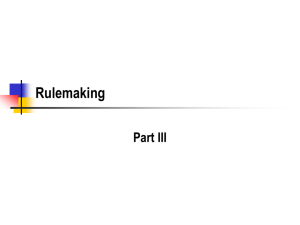
![Minnesota Department of [Name] MEMORANDUM](http://s2.studylib.net/store/data/015049440_1-475d22d0ab7bd661c71329dec0ae8429-300x300.png)
